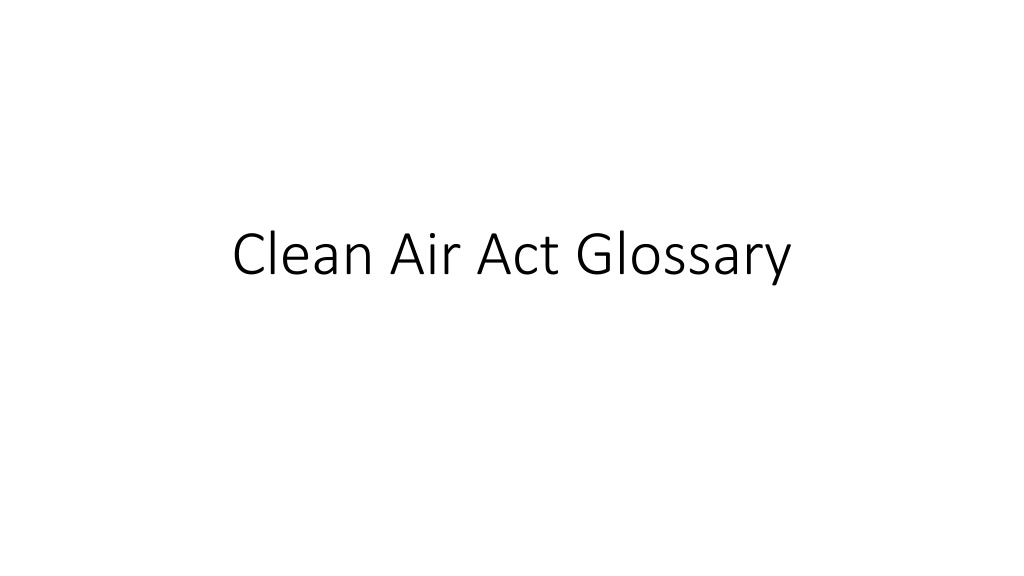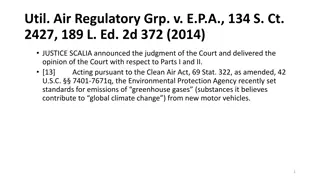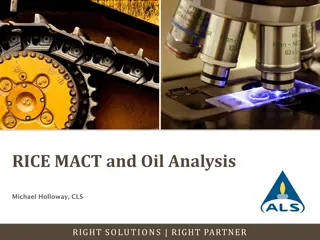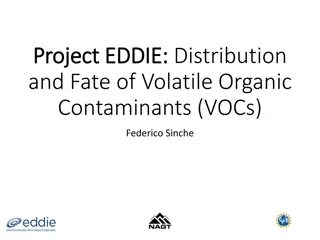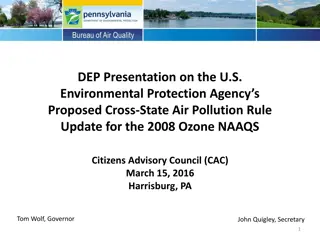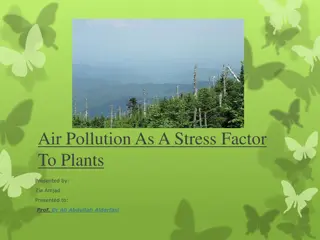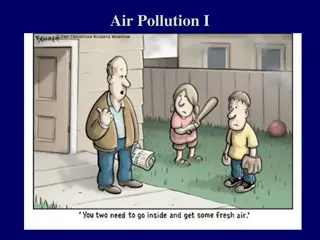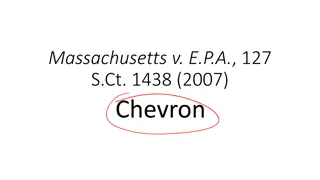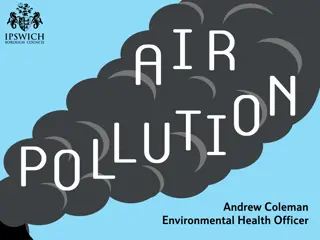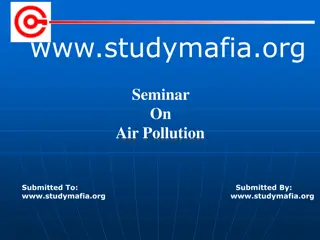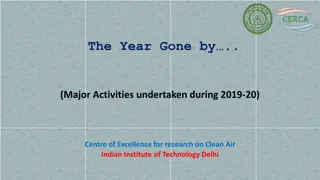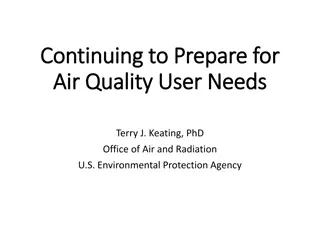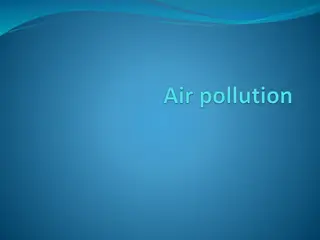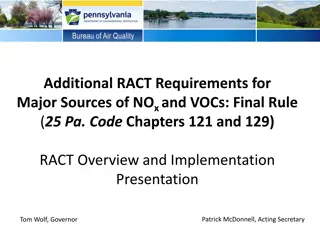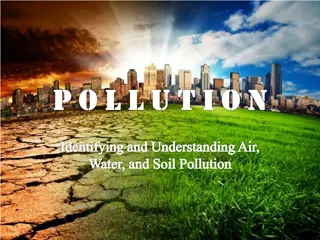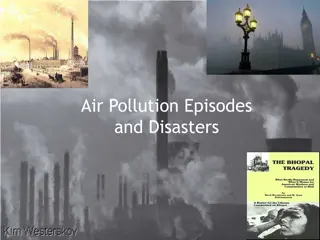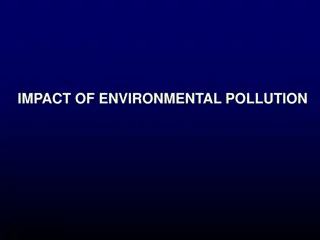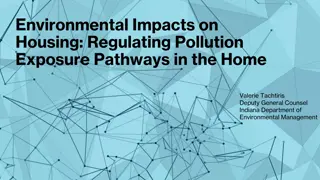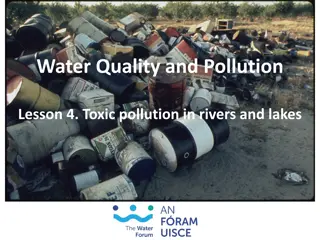Overview of Clean Air Act: Criteria Pollutants, NAAQS, HAPs, VOCs
The Clean Air Act establishes standards for criteria pollutants like ozone and particulate matter to protect human health. NAAQS set uniform air quality goals, while Hazardous Air Pollutants (HAPs) pose threats such as cancer. Volatile Organic Compounds (VOCs) and National Emission Standards for HAPs govern emissions.
Download Presentation

Please find below an Image/Link to download the presentation.
The content on the website is provided AS IS for your information and personal use only. It may not be sold, licensed, or shared on other websites without obtaining consent from the author. Download presentation by click this link. If you encounter any issues during the download, it is possible that the publisher has removed the file from their server.
E N D
Presentation Transcript
Criteria Pollutants Criteria Pollutants are certain pollutants known to be harmful to human health and welfare and for which National Ambient Air Quality Standards are established. EPA has identified and set standards to protect human health and welfare for ozone, carbon monoxide, particulate matter, sulfur dioxide, lead, and nitrogen oxide. Criteria Pollutants are established by regulation, but the list has not been expanded in decades.
National Ambient Air Quality Standards (NAAQS) Clean Air Act section 109 instructs EPA to establish uniform national standards for air quality for widespread air pollutants, known as criteria air pollutants. 42 U.S.C. 7409. NAAQS set a goal for the concentration of air pollutants in the ambient air (air quality). They do not directly address the amount of pollutants emitted by sources (emissions). Clean Air Act section 109(d)(1) directs EPA to review the NAAQS for criteria air pollutants every five years and, if warranted, to revise the standards as may be appropriate. The NAAQS do not themselves regulate emissions, but they create an important goal for many of the Act s regulatory programs. The primary NAAQS is set at a level that protects public health. The secondary NAAQS can protect property and other interests. What does a NAAQS look like?
Hazardous Air Pollutants (HAPS) Hazardous Air Pollutants, also known as toxic air pollutants or air toxics, are air pollutants not covered by ambient air quality standards (NAAQS) but which as defined in the Clean Air Act, may present a threat of adverse human health effects, such as cancer or birth defects, or adverse environmental and ecological effects. Such pollutants include asbestos, beryllium, mercury, benzene, coke oven emissions, radionuclides, and vinyl chloride.
Volatile Organic Compound (VOC) Any organic compound that participates in atmospheric photochemical reactions except those designated by EPA as having negligible photochemical reactivity
National Emission Standards for Hazardous Air Pollutants (NESHAPs) The Clean Air Act regulates hazardous air pollutants separately from other air pollutants. Clean Air Act section 112 requires EPA to set technology-based limits on emissions of hazardous air pollutants for categories of new and existing stationary sources of hazardous air pollutant emissions. 42 U.S.C. 7412.
Emission Standard The maximum legally allowable air pollution discharge from a source.
State Implementation Plans (SIPs). Clean Air Act section 110 and other provisions direct states to develop state implementation plans aimed at bringing local air quality into compliance with the NAAQS. 42 U.S.C. 7410. Although EPA establishes uniform NAAQS for the entire country, states have considerable discretion when developing and implementing their SIPs to decide how to regulate air pollutant emissions.
Federal Implementation Plan (FIP) A federally implemented plan to achieve attainment of air quality standards and is used when a state is unable to develop an adequate plan
New Source Review (NSR) Clean Air Act section 165 requires anyone planning on building a major new stationary source of air pollution to obtain a permit before commencing construction of the source. 42 U.S.C. 7475. The permitting process for these new sources is called New Source Review and is designed to ensure that a new source will not unduly degrade air quality and will use the most stringent emissions controls that are feasible for the source.
New Source Performance Standards (NSPS). Clean Air Act section 111 directs EPA to establish standards of performance for categories of new stationary sources of emissions that contribute significantly to air pollution. 42 U.S.C. 7411.
Major Sources Sources that exceed a threshold based on actual or potential emissions so as to trigger certain emissions limitations or permitting requirements. Under the New Source Review program (NSR), sources in nonattainment areas with potential to emit 25, 50, or 100 tons per year (tpy) or more (depending on severity of nonattainment) of regulated pollutants are major sources. In attainment areas, major sources subject to Prevention of Significant Deterioration (PSD) provisions are those with potential to emit 100 or 250 tpy or more, depending upon the source category. [EPA has modified the major source threshold for greenhouse gases under PSD through the tailoring rule. ] For hazardous air pollutants (HAPs), major sources are those with potential to emit 10 tpy or more of any single HAP or 25 tpy or more of a combination of HAPs.
Stationary Source An immobile source of pollution, such as a power plant or industrial facility.
Mobile Sources Clean Air Act section 202 instructs EPA to set emissions standards that limit pollution from mobile sources. 42 U.S.C. 7521. Clean Air Act section 211 also directs EPA to regulate vehicle fuels and fuel additives that contribute to air pollution. 42 U.S.C. 7545.
Best Available Control Technology (BACT) A pollution control standard based on the maximum degree of emission reduction (considering energy, environmental, and economic impacts) achievable through application of production processes and available methods, systems, and techniques. BACT is required under EPA s new source review program and is implemented on a case-by-case basis for major new or modified emissions sources in attainment areas (areas that are meeting the applicable National Ambient Air Quality Standard) and applies to each regulated pollutant.
Maximum Available Control Technology (MACT) A pollution control standard for sources of air pollution requiring the maximum reduction of hazardous emissions, taking cost and feasibility into account. Under the Clean Air Act Amendments of 1990, the MACT must not be less than the average emission level achieved by controls on the best performing 12 percent of existing sources, by category of industrial and utility sources.
Reasonable Available Control Technology (RACT) Control technology which is both economically and technologically feasible and reasonably available. Generally applied as a standard to existing sources in nonattainment areas, and is usually less stringent than new source performance standards (NSPS).
Operating Permits Legally enforceable documents issued mostly by state and local permitting authorities to individual air pollution sources, which include enforceable standards applicable to those sources. Under title V of the Clean Air Act, all large sources and a limited number of smaller sources of air pollution are required to obtain operating permits that assure compliance with all provisions of the Act.
Prevention of Significant Deterioration (PSD) An EPA program in which state and/or federal permits are required in order to restrict emissions from major sources or major modifications in places where air quality already meets or exceeds primary and secondary ambient air quality standards.
Attainment Area An area which meets National Ambient Air Quality Standards (NAAQS) as defined in the Clean Air Act. An area may be an attainment area for one criteria pollutant, while simultaneously being a nonattainment area for another criteria pollutant.
Nonattainment Area An area where levels of one or more criteria air pollutants do not meet the National Ambient Air Quality Standards (NAAQS). An area may be an attainment area for one pollutant, while simultaneously being a nonattainment area for another pollutant.
Lowest Achievable Emission Rate (LAER) The emissions rate that reflects the most stringent limitation in the implementation plan of any state, unless demonstrably unachievable, in which case, LAER is the most stringent limitation achieved in practice. LAER is applied to major new or modified emissions sources in nonattainment areas.
Offsets A concept whereby emissions from proposed new or modified stationary sources are balanced by reductions from existing sources to stabilize total emissions. Offsets at a greater than 1:1 ratio result in net reductions in emissions.
Emissions Trading A system in which multiple emitters may exchange emissions allowance permits, allowing the system as a whole to meet emissions limits or reduction targets.
